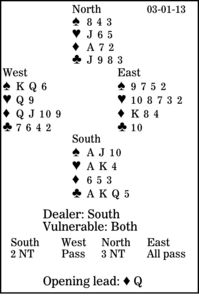Bridge column, March 1: Do not overlook the second chance

The happiest bridge player rigorously plans his campaigns, although sometimes his success is open to chance, depending on where the missing high cards are located.
In this deal, South is in three no-trump. After West leads the diamond queen, how should South plan the play?
Remember that when you open one or two no-trump, do not be neurotic about a weak suit. It is your partner's job to cover that suit; you cannot be expected to do everything.
South starts with eight top tricks: one spade, two hearts, one diamond and four clubs. In isolation, by far the best chance of a ninth winner is to take two spade finesses. One will work 76 percent of the time. However, those finesses are into the West hand, the defender who presumably holds the diamond length.
Declarer should duck the first two diamond tricks, then take the third with dummy's ace, being relieved to see that the suit is 4-3, not 5-2. Then South plays a spade to his jack.
West wins, cashes his last diamond, and shifts to a club. How should declarer continue?
It looks obvious to win with dummy's jack and to take the second spade finesse. However, South has a second chance to get home, unlikely though it may be. He should take the club trick in his hand and cash his top hearts. Yes, only just under 10 percent of the time will the queen drop, but it is better than nothing before -- probably -- falling back on the second spade finesse.
** ** **
COPYRIGHT: 2013, UNITED FEATURE SYNDICATE
DISTRIBUTED BY UNIVERSAL UCLICK FOR UFS

